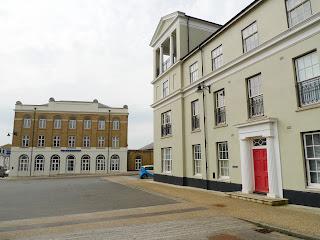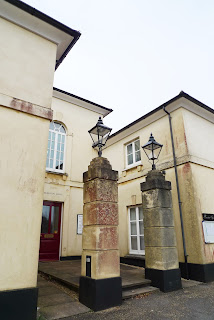Recently I've been mining the vast Melford Photo Archive on the PC for pictures. And I've come across a set of photos, taken in the 1990s, of the Tricorn Centre in Portsmouth.
This Brutalist development from the 1960s became a Hampshire - and latterly a national - byword for gross ugliness. It was the worst possible advertisement for Portsmouth, that proud city associated with Royal Navy tradition; the base for many warships, including HMS Victory, Nelson's flagship at Trafalgar. The Tricorn was built in plain bulky concrete. It looked awful. Nobody ever liked it. Surely nobody ever really wanted it in the first place. You do wonder if there were background reasons, never divulged, as why the architects got the commission, or why the building contractor got the go-ahead. It was never a commercial success. It never had prestigious tenants. It did not age well. It became a very bad joke. It was in the end mainly an awkward-to-drive-into-and-out-of city centre car park. It was finally pulled down in 2004. Strangely, it had by then some eager champions, people who understood twentieth-century architecture and wanted it saved and brought back to life. They were thankfully ignored.
Don't take my word for it. Here are some links:
https://en.wikipedia.org/wiki/Tricorn_Centre
https://en.wikipedia.org/wiki/Brutalist_architecture
But you can trust my photographs. These were taken in 1999, five years from the end:
I think that's the differently-styled Cascades Shopping Centre, bottom left in the shot just above. It instantly became the nicer and much more successful shopping place to go to. In 1999 the contrast between the two, so close, was uncomfortable. Here are some more 1999 shots:
Nothing much at ground level: cheap shops mostly; by 1999 mostly boarded up. Who knows what kind of people lurked in there at night. Two years later in 2001, it was even nastier and tattier, except for the ever-useful car park:
I thought the spiral inclines for the rooftop car park were the best feature left, but even they were drab and dingy. And they were hardly easy to use from the driver's point of view. Spiral entrances are now definitely out of favour, and have been replaced in Crawley (at the County Mall) and - from memory - at Bexley. But they were once thought swish and trendy - and space-saving. Except what do you do with the unsweepable space below the lowermost spiral? Leave it to the tramps and the homeless?
I have of course no professional opinion to give on Brutalism. But I can photographically compare the Tricorn with somewhere like Poundbury, on the west side of Dorchester in Dorset. Poundbury is a longstanding housing development encouraged by the Prince of Wales himself. It continues to be built in the same consistent style. I went there in 2004, and then again in 2014, and found the 2014 version looking more 'mature' than ten years before, but very much a straightforward extension of what was originally there, as future builds will surely be too. Here are various views from 2004:
And below, 2014:
I think there is no question as to which is the more attractive. Age has not withered nor custom staled Poundbury's infinite variety. For one thing, it isn't really old. These were once green fields. It's designed to be an agreeable interpretation of what an Ideal Renaissance Town would be like in the modern era. Indeed, you must fully understand that concept, not only in order to make sense of Poundbury, but also in order to want to live there. This is no place for the uneducated or uncultured. It's a little Urbino in the countryside for professional persons - and not for ploughmen and shepherds. Nor do I think it's meant for young children or badly-behaved pets. I imply not the slightest criticism. I myself would consider living there, if ever I wanted to inhabit a townscape. It would be a pleasure to walk around in it.
Poundbury is obviously an architectural pastiche, with many recognisable idioms from those past eras when good proportion, solid-looking materials, and intriguing sight-lines were especially valued. I personally wish there were more trees, more grass, and less of a ghost-town atmosphere; but it undeniably offers upmarket, quiet, spacious, stress-free living for those with decent incomes. It has a slightly exclusive air: no riff-raff wanted here! And I dare say none come. There are surely no smelly corners where poor people shelter from Dorset winds.
The place has avoided the Marina Look. And the turreted Tesco Superstore Look, even though there certainly are 'bell-towers' here and there. It's still however very much an artificial contrivance. Some would say fake. And although I'd agree wholeheartedly that it's visually successful and impressive, and well thought-out, I'd hesitate to describe Poundbury as 'beautiful', even if some individual buildings (whether new, or not-quite-so-new) have beautiful lines. Nor is it 'exciting'.
But 'very attractive' suffices. There's no thatch; and concrete has been freely used where it can be disguised; but there is also plenty of brick, and some stone too. I can't see Poundbury getting dingy. It will acquire a patina, and will not be pulled down in disgust by a future generation.
Back to the Tricorn and the Brutalist approach. I will say this about such ugly concrete constructions, that they looked hard and strong and totally uncompromising. Surely the minds of their architects were exactly the same: visionaries whose eyes glinted through steel-rimmed spectacles, imagining a utilitarian world full of rectangular blocks, hard lines, heavy accents, rough textures. All the stark elements of superhuman Ancient Egyptian pyramids and temples, or Mesopotamian ziggurats. But Le Corbusier and his kind were the angry children of defeated parents, maimed and broken, but able to impose their revenge through sheer bad temper and fearsome reputation. They were not seen that way in their time, of course, as failed human beings. Le Corbusier was still greatly admired when I was engaged in A-level Art in the late 1960s, still an inspiration. I had a particular school friend then called by everyone 'Doc' White, who yearned to be an architect just like Le Corbusier, and was constantly sketching ideal 'machines for living'. Doc also introduced me to The Beatles' Abbey Road album, almost their last flowering as a functioning group. I do wonder what happened to him. I grabbed my A-levels and ran. He went on to university somewhere, as most everybody else did.
There is idealism, but nothing of the superhuman, about Poundbury. I imagine there have been a succession of architects working on it over the years, all happily able to design fresh buildings and neighbourhoods within quite stringent design constraints. The really big beasts of architecture have not made their mark there. Perhaps it is the wrong location. Dorchester is not a great city, and needs no huge stadium or high tower. And Poundbury itself is really just a posh village: built on a human scale for human beings to enjoy. It could perhaps swallow a big bronze statue from a well-known artist. Something on the lines of a Henry Moore or Barbara Hepworth would be fine, were one available. But not Damien Hirst's Verity, the big viscerally pregnant female figure at Ifracombe. It just wouldn't look right in Poundbury's Neo-Renaissance streets.
Although come to that, Verity wouldn't have seemed right next to the Tricorn. Nothing would.
skip to main |
skip to sidebar

Search my blog
Total Pageviews
Lucy Melford on Flickr
About Me

- Lucy Melford
- Sussex, United Kingdom
- This is really my autobiography, written as I go along. I'm getting older, more aware of how time is passing, and so much still to do and experience. I want to share what happens to me here, on my blog. I hope you find at least some of it interesting and enlightening.
Blog Archive
-
▼
2016
(190)
-
▼
June
(19)
- Decree Absolute
- Done in full knowledge of the consequences
- Aftermath
- Voting in the Referendum
- Sex on sofas, and other observations
- Last days of the Ancien Régime
- Burgess Hill shoppers threatened with arrest by th...
- Gun law
- Brutalism: the Tricorn Centre in Portsmouth
- The simplest thing, but...
- The Dinky Doo Diner
- Where have all the billboards gone?
- A sad little tale of Them and Us
- Men try it on
- Honey, I kicked the hedgehog!
- The quality of life
- The new Top Gear - did they pull it off?
- The Empire gobbles up more of the country
- Over here
-
▼
June
(19)
































